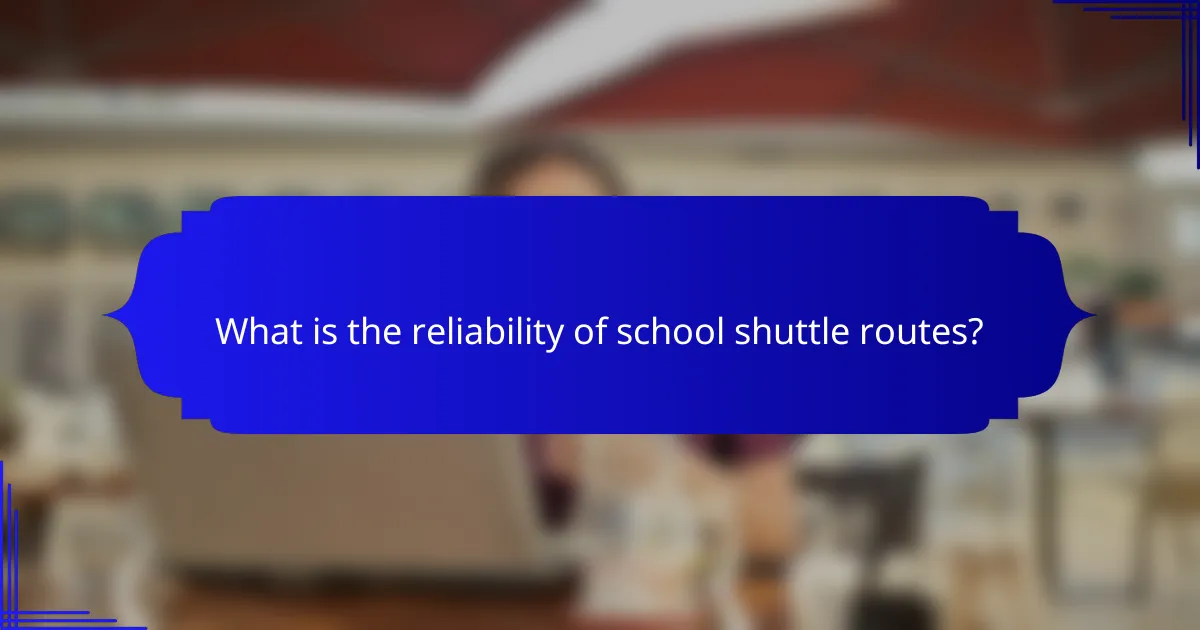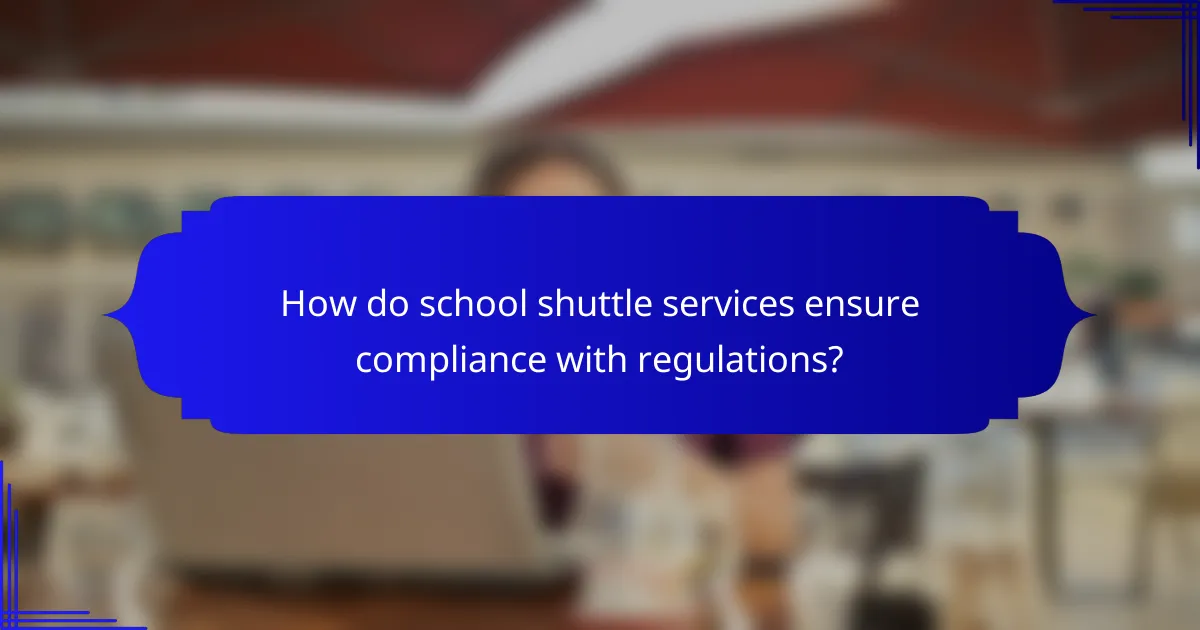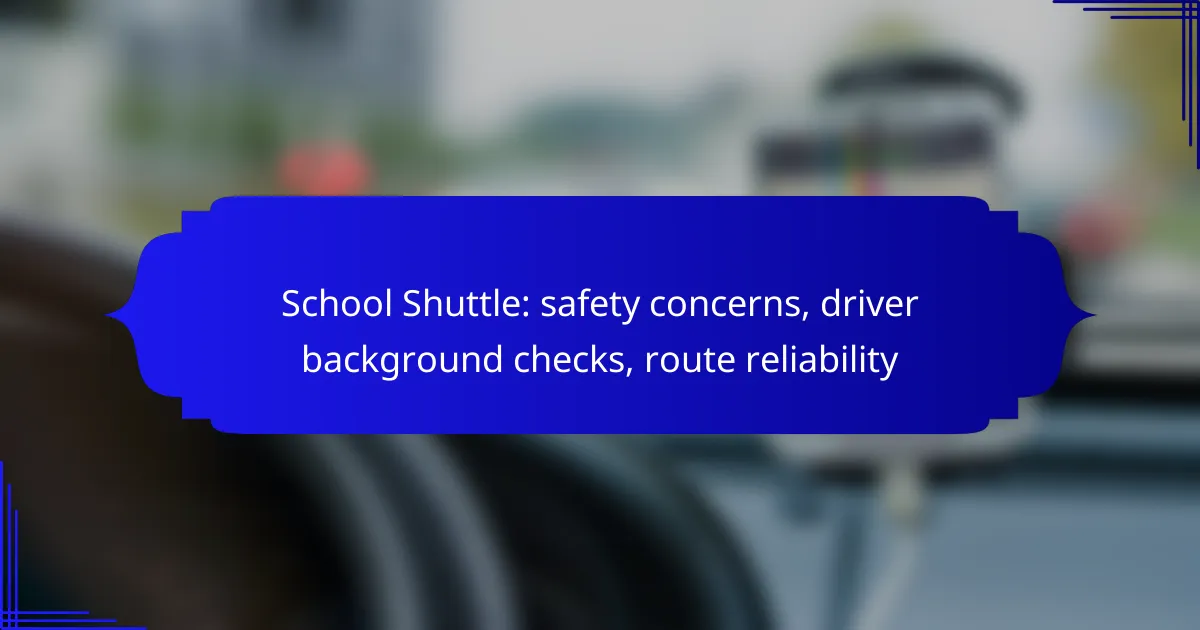Ensuring the safety of school shuttles is paramount, encompassing vehicle maintenance, emergency preparedness, and the qualifications of drivers. Comprehensive background checks are conducted to assess a driver’s criminal history and driving record, ensuring that only qualified individuals transport students. Additionally, the reliability of shuttle routes is critical, as it affects students’ timely arrivals and departures, influenced by effective route planning and real-time tracking.

What are the safety concerns for school shuttles in the UK?
Safety concerns for school shuttles in the UK include vehicle maintenance, emergency preparedness, and driver qualifications. Ensuring that these aspects are properly managed is crucial for the well-being of students during their commutes.
Vehicle maintenance standards
Vehicle maintenance standards are essential for ensuring that school shuttles operate safely and reliably. Regular inspections, servicing, and adherence to manufacturer guidelines help prevent mechanical failures that could endanger passengers.
In the UK, shuttles must comply with the Road Traffic Act, which mandates that vehicles undergo annual safety checks. Schools should maintain a log of maintenance records to ensure compliance and safety.
Emergency protocols
Emergency protocols are critical for responding effectively to incidents that may occur during transit. Schools should establish clear procedures for various scenarios, including medical emergencies, vehicle breakdowns, or accidents.
Training drivers in first aid and equipping shuttles with emergency kits can significantly enhance safety. Regular drills can also prepare both drivers and students for potential emergencies, ensuring everyone knows their roles.
Driver training requirements
Driver training requirements are vital for ensuring that school shuttle drivers are well-prepared to handle their responsibilities. In the UK, drivers must hold a valid driving license and may need additional qualifications, such as a Certificate of Professional Competence (CPC).
Ongoing training programs should cover topics like child safety, defensive driving, and emergency response. Schools should verify that drivers have undergone background checks to ensure a safe environment for students.

How are driver background checks conducted?
Driver background checks are conducted through a systematic process that evaluates a candidate’s criminal history, driving record, and references. These checks ensure that school shuttle drivers meet safety standards and are qualified to transport students responsibly.
Criminal record checks
Criminal record checks involve searching national and local databases to identify any past criminal activity. This process typically includes reviewing felony and misdemeanor records, which can vary by state in terms of what is disclosed and how far back the search goes.
Many states require employers to obtain written consent from the applicant before conducting these checks. It’s essential for schools to comply with local laws regarding the use of criminal history in hiring decisions, ensuring that only qualified individuals are entrusted with student safety.
Driving history verification
Driving history verification assesses a candidate’s past driving performance by reviewing their motor vehicle records (MVR). This includes checking for traffic violations, accidents, and any license suspensions or revocations.
Schools should look for a clean driving record, ideally free of serious infractions, over a period of several years. A history of reckless driving or multiple violations may indicate a higher risk for future incidents, which is critical to consider when hiring drivers for school shuttles.
Reference checks
Reference checks involve contacting previous employers or other relevant contacts to gather insights about the candidate’s work ethic, reliability, and behavior. This step can provide valuable context beyond what is found in criminal and driving records.
When conducting reference checks, it is advisable to ask specific questions related to the candidate’s experience with children, punctuality, and overall professionalism. This feedback can help schools make informed decisions about hiring drivers who will prioritize student safety and well-being.

What is the reliability of school shuttle routes?
The reliability of school shuttle routes refers to how consistently and predictably these services operate, ensuring students arrive at school and return home on time. Factors influencing reliability include route planning, real-time tracking, and feedback from parents.
Route planning processes
Effective route planning is essential for ensuring that school shuttles operate reliably. This involves mapping out the most efficient paths that consider traffic patterns, road conditions, and student locations. Schools often collaborate with transportation experts to develop routes that minimize travel time while maximizing safety.
When planning routes, it’s crucial to regularly review and adjust them based on changing student needs or road conditions. For example, if a new housing development opens, the route may need to be modified to accommodate additional students.
Real-time tracking technologies
Real-time tracking technologies enhance the reliability of school shuttle routes by providing live updates on shuttle locations. Many schools use GPS systems that allow parents to monitor their child’s shuttle in real time through mobile apps or websites. This transparency helps alleviate concerns about delays or unexpected route changes.
Additionally, these technologies can alert drivers and school officials to potential issues, such as traffic jams or mechanical problems, enabling quick responses to maintain schedule adherence. Schools should ensure that the tracking systems are user-friendly and accessible for parents.
Feedback mechanisms from parents
Establishing feedback mechanisms from parents is vital for improving the reliability of school shuttle services. Schools can implement surveys or feedback forms to gather parents’ insights on shuttle performance, safety concerns, and suggestions for improvement. Regular communication helps build trust and ensures that parents feel heard.
Moreover, schools should create a clear process for addressing feedback and making necessary adjustments. For instance, if multiple parents report issues with a particular route, the school can investigate and make changes to enhance reliability and safety for all students.

What criteria should parents consider when choosing a school shuttle service?
Parents should prioritize safety, driver qualifications, and insurance coverage when selecting a school shuttle service. These factors ensure that children are transported securely and responsibly, minimizing risks associated with school commutes.
Safety ratings and reviews
Safety ratings and reviews provide insight into a shuttle service’s reliability and performance. Parents can check online platforms or local community boards for feedback from other families regarding their experiences. Look for services with high ratings and positive testimonials, as these often indicate a strong commitment to safety.
Additionally, consider any safety certifications the service may hold. Compliance with local safety regulations and standards can further assure parents of the shuttle’s reliability.
Driver qualifications
Driver qualifications are crucial in ensuring a safe shuttle experience. Verify that drivers have undergone thorough background checks, including criminal history and driving record evaluations. Many services also require drivers to have specific licenses or certifications, which can enhance their competency.
Inquire about ongoing training programs for drivers, as these can help maintain high safety standards and improve their skills in handling various situations on the road.
Insurance coverage details
Understanding the insurance coverage details of a school shuttle service is essential for parents. Ensure that the service carries adequate liability insurance to cover any potential accidents or incidents. This coverage should typically meet or exceed local regulatory requirements.
Request documentation that outlines the insurance policy, including coverage limits and what is included. Knowing that a service is well-insured can provide peace of mind for parents entrusting their children to the shuttle.

How do school shuttle services ensure compliance with regulations?
School shuttle services ensure compliance with regulations through a combination of regular audits, inspections, and adherence to local transport laws. These practices help maintain safety standards and reliability in transporting students.
Regular audits and inspections
Regular audits and inspections are essential for maintaining compliance in school shuttle services. These evaluations typically occur annually or biannually and assess vehicle condition, safety equipment, and operational procedures.
During these audits, services may check for proper maintenance records, driver qualifications, and adherence to safety protocols. This proactive approach helps identify potential issues before they become serious problems.
Adherence to local transport laws
Adhering to local transport laws is crucial for school shuttle services to operate legally and safely. Regulations can vary significantly by region, so it’s important for services to stay informed about specific requirements in their area.
Common regulations include driver background checks, vehicle safety standards, and insurance coverage. Failure to comply with these laws can result in fines, legal issues, and jeopardized student safety.

What emerging trends are shaping school shuttle services?
Emerging trends in school shuttle services include the adoption of electric vehicles and the integration of artificial intelligence for route optimization. These innovations aim to enhance safety, reduce environmental impact, and improve efficiency in transporting students.
Electric vehicle adoption
The shift towards electric vehicles (EVs) in school shuttle services is gaining momentum due to their lower emissions and reduced operating costs. Schools are increasingly considering EVs as a sustainable alternative to traditional diesel buses, which can lead to significant savings on fuel and maintenance.
When evaluating electric shuttles, factors such as battery range, charging infrastructure, and total cost of ownership are crucial. Many electric school buses can cover typical daily routes without needing a recharge, making them practical for most districts.
Integration of AI for route optimization
Artificial intelligence is transforming route planning for school shuttles by analyzing traffic patterns, weather conditions, and student locations to create the most efficient routes. This technology can reduce travel times and improve punctuality, ensuring students arrive at school and home on schedule.
Implementing AI-driven systems can help school districts minimize fuel consumption and enhance safety by avoiding congested areas. Regularly updating algorithms based on real-time data can further optimize routes, making it essential for schools to invest in this technology for better service delivery.
